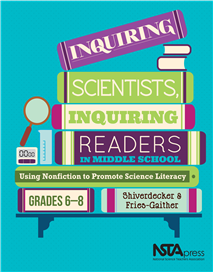Inquiring Scientists, Inquiring Readers in Middle School
By Carole Hayward
Posted on 2016-12-07
Reading can be fun. For science-loving kids, using science-based texts can be an exciting way to increase understanding of concepts. A new NSTA Press book provides a plethora of ways to use nonfiction texts for inquiry-based science instruction.
 Inquiring Scientists, Inquiring Readers in Middle School: Using Nonfiction to Promote Science Literacy, Grades 6-8 by Terry Shiverdecker and Jessica Fries-Gaither offers strategies for integrating science and literacy instruction alongside ten in-depth units that are aligned with both the Next Generation Science Standards and the Common Core State Standards, English Language Arts.
Inquiring Scientists, Inquiring Readers in Middle School: Using Nonfiction to Promote Science Literacy, Grades 6-8 by Terry Shiverdecker and Jessica Fries-Gaither offers strategies for integrating science and literacy instruction alongside ten in-depth units that are aligned with both the Next Generation Science Standards and the Common Core State Standards, English Language Arts.
Middle school is a critical time in a child’s educational career. “We know that today’s students often arrive in middle school with specific needs in terms of reading and writing, which can frustrate teachers who have not received subject-specific guidance in meeting those needs,” the authors state in the book’s introduction.
The book is meant to integrate literacy lessons in a meaningful way without losing the focus on science. “We strongly believe that any effort to integrate literacy into science instruction must do so while still preserving the quality of the science instruction itself. In our approach, literacy activities support the acquisition of science content through inquiry-based instruction. They do not replace active engagement with data with reading about science concepts,” write Shiverdecker and Fries-Gaither.
Each unit includes a range of activities that have students exploring, engaging, explaining, and doing activities such as writing blog posts, conducting research, and using graphic organizers.
For example, in the lesson “Nature’s Light Show: It’s Magnetic!”(chapter 10) students learn about the Northern and Southern Lights through a combination of hands-on investigation and reading assignments. The unit asks the question, “What causes Earth’s aurora?” Students will have a chance to summarize and synthesize the ideas in a nonfiction text, draw and describe Earth’s magnetic field, and explain the phenomenon of the aurora.
In addition to being a great tool for literacy, the book also addresses a range of intriguing topics that will interest middle school students, such as animal and plant cell structure, genetic testing, and the relationship between sunlight and the seasons.
Check out the free sample chapter “Landfill Recovery” and get your copy of Inquiring Scientists, Inquiring Readers. This release is a follow-up to Fries-Gaither and Shiverdecker’s successful book for grades 3-5.
Follow NSTA
Save
Disclaimer: The views expressed in this blog post are those of the author(s) and do not necessarily reflect the official position of the National Science Teaching Association (NSTA).


